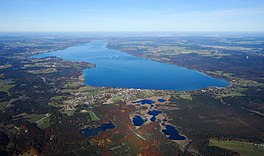Lake Starnberg
| Lake Starnberg | |
|---|---|
 Aerial view of Lake Starnberg from the south | |
| Location | Bavaria |
| Coordinates | 47°54′14″N11°18′26″E/ 47.90389°N 11.30722°E |
| Type | Natural lake |
| Primary inflows | Steinbach or Ostersee-Ach |
| Primary outflows | Würm |
| Catchment area | 314 km2(121 sq mi) |
| Basincountries | Germany |
| Max. length | 20.2 km (12.6 mi) |
| Surface area | 58.36 km2(22.53 sq mi) |
| Max. depth | 127.8 m (419 ft) |
| Water volume | 2,998×106m3(105.9×109cu ft) |
| Residence time | 21 years |
| Surface elevation | 596 m (1,955 ft) |
| Islands | Roseninsel |
| Settlements | Starnberg,Ammerland,Seeshaupt,Tutzing,Feldafing,Possenhofen |
| Official name | Starnberger See |
| Designated | 26 February 1976 |
| Reference no. | 94[1] |
Lake Starnberg,orStarnberger See[ˈʃtaʁnbɛʁɡɐˌzeː]) — calledLake WürmorWürmsee[ˈvʏʁmˌzeː]until 1962 — isGermany's second-largest body of fresh water, having great depth, and fifth-largest lake by area.[2]It and its surroundings lie in three different Bavarian districts, orLandkreise.The lake is property of the state and accordingly managed by theBavarian Administration of State-Owned Palaces, Gardens and Lakes.
Located in southernBavaria25 kilometres (16 mi) southwest ofMunich,Lake Starnberg is a popular recreation area for the city and, since 1976, one of the wetlands of international importance protected by theRamsar Convention.The small town ofBergis famous as the site whereKing Ludwig II of Bavariawas found dead in the lake in 1886. Because of its associations with theWittelsbachroyal family, the lake is also known as Fürstensee (Prince's Lake). It is also mentioned inT. S. Eliot's poemThe Waste Land.
Overview
[edit]The lake, lying in azungenbeckenor glacial hollow, was created byice ageglaciersfrom theAlps,and extends 21 km (13 mi) from north to south and has a width of 3–5 km (2-3.5 miles) from east to west. It has a single small island, theRoseninsel,and a single outlet, theWürmriver (because of this river the lake was called theWürmseeuntil 1962). Its major inflow comes from a small river called the Steinbach or Ostersee-Ach, which flows through a chain of small lakes to the south, theOsterseen.The lake's water is of excellent quality due to the introduction in the 1960s of a circular sewerage system which collects wastewater from the settlements around the lake and transports it to a treatment plant below the lake's outlet atStarnberg.Bronze fish-hooks and adugoutdating to the 9th or 8th century BCE have been discovered at the lake, and there are still some professionalfishers,most of them continuing a family tradition.
Hikers and cyclists can circumnavigate the lake using a path approximately 49 kilometres (30 mi) long. Access to the lake shore is not possible everywhere, since it is mostly private property. Passenger ferries and excursion ships have operated on the lake since 1851. Today they are operated by theBayerische Seenschifffahrtcompany, using modern diesel-engined ships.[3][4]
Name
[edit]The earliest surviving mention of the lake, asUuirmseo,is in an 818 document referring to Holzhausen, now part ofMünsing.[5]This name becameWirmsee,already recorded during the reign of theHoly Roman EmperorLouis the Bavarian(1314–1347).[6]This name is derived from the Wirm, now speltWürm,the only river which flows out of the lake, at Starnberg; in the 19th century, the spellings were changed to Würm and Würmsee.
In the late 19th century, a railway connection between Munich and Starnberg made the lake an accessible destination for trips from the city. Trains departed from a wing of theMunich Central Stationwhich was known as the 'Starnberg branch station' (Starnberger Flügelbahnhof) and the lake came increasingly to be known as Lake Starnberg; its name was finally officially changed in 1962.
Settlements
[edit]
Clockwise from the north, the following settlements about the lake:
- Starnberg(North,Starnberg district)
- Berg(North East, Starnberg district): including Kempfenhausen, Berg and Leoni
- Münsing(South East,Bad Tölz-Wolfratshausendistrict): including Ammerland, Ambach, Pischetsrieder and St. Heinrich
- Seeshaupt(South,Weilheim-Schongaudistrict): including Seeseiten
- Bernried(South West, Weilheim-Schongau district)
- Tutzing(West, Starnberg district): including Unterzeismering;Evangelische Akademie Tutzingon the lake
- Feldafing(North West, Starnberg district): including Garatshausen
- Pöcking(North West, Starnberg district): includingPossenhofenand Niederpöcking
Off the western shore, south of Possenhofen, is the smallRoseninsel(Rose Island), the site of a royal villa ofLudwig II.
Panorama
[edit]References
[edit]- ^"Starnberger See".RamsarSites Information Service.Retrieved25 April2018.
- ^Bayregio."The lake Starnberger See".BAYregio-Starnberger-See.de. Archived fromthe originalon 25 August 2011.Retrieved8 August2011.
- ^"Lake Starnberg".Bayerische Seenschifffahrt GmbH.Retrieved2018-12-24.
- ^"Geschichtliche Hintergründe"[Historical Background] (in German). Bayerische Seenschifffahrt. Archived fromthe originalon 2011-12-10.Retrieved2011-07-11.
- ^Würmsee, in: Arbeitskreis für Ortsgeschichteforschung der Würmregion,Materialien zur Ortsgeschichtsforschung in der Würmregion,Gauting 2001, p. 245.
- ^Bayerische Staatsbibliothek,S. 289,Regesten Kaiser Ludwigs des Bayern - Die Urkunden aus Klöstern und Stiftsarchiven im Bayerischen Hauptstaatsarchiv und in der Bayerischen Staatsbibliothek,ed. Menzel, 1996(in German)[https://web.archive.org/web/20120330071423/http://regesta-imperii.digitale-sammlungen.de/regest/ri07_ri_1341-02-05_000002_000001_007_001_003_000638_0000000638 ArchivedMarch 30, 2012, at theWayback Machine
Further reading
[edit]- Martinus Fesq-Martin, Amei Lang and Michael Peters (Eds.).Der Starnberger See—Natur und Vorgeschichte einer bayerischen Landschaft.Munich, 2008.ISBN978-3-89937-090-4(in German)
- A. Link.Der Starnberger See und seine Umgebung vom Würmtal bis zum Alpenrand.Gauting-Buchendorf, 1982.ISBN3-923657-06-4(in German)
- Susanne Westendorf.Das Starnberger-SeeBuch—eine Tour um den See, kleiner Führer.Munich, 1995.ISBN3-00-000232-4(in German)
- Lorenz von Westenrieder.Beschreibung des Wurm- oder Starenbergersees und der umherliegenden Schlösser, samt einer Landkarte.1783, repr. Dachau: Bayerland, 2006.ISBN3-89251-367-8(in German)
- Oskar Weber and Josef Wahl.Am Starnberger See und die Würm entlang.Dachau, 1995.ISBN3-89251-202-7(in German)
External links
[edit]- Nixdorf, B.; et al. (2004),"Starnberger See",Dokumentation von Zustand und Entwicklung der wichtigsten Seen Deutschlands(in German), Berlin: Umweltbundesamt, p. 75
- Pictures of Lake Starnberg



